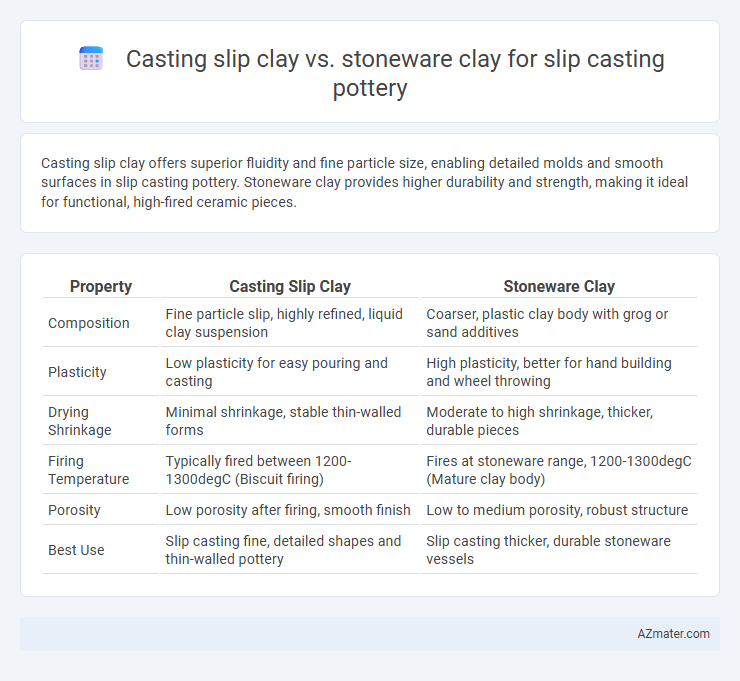Casting slip clay offers superior fluidity and fine particle size, enabling detailed molds and smooth surfaces in slip casting pottery. Stoneware clay provides higher durability and strength, making it ideal for functional, high-fired ceramic pieces.
Table of Comparison
| Property | Casting Slip Clay | Stoneware Clay |
|---|---|---|
| Composition | Fine particle slip, highly refined, liquid clay suspension | Coarser, plastic clay body with grog or sand additives |
| Plasticity | Low plasticity for easy pouring and casting | High plasticity, better for hand building and wheel throwing |
| Drying Shrinkage | Minimal shrinkage, stable thin-walled forms | Moderate to high shrinkage, thicker, durable pieces |
| Firing Temperature | Typically fired between 1200-1300degC (Biscuit firing) | Fires at stoneware range, 1200-1300degC (Mature clay body) |
| Porosity | Low porosity after firing, smooth finish | Low to medium porosity, robust structure |
| Best Use | Slip casting fine, detailed shapes and thin-walled pottery | Slip casting thicker, durable stoneware vessels |
Introduction to Slip Casting Pottery
Slip casting pottery utilizes liquid clay, or slip, poured into plaster molds to create detailed ceramic forms with precision. Casting slip clay, formulated for optimal fluidity and fine particle suspension, ensures smooth mold filling and minimizes air bubbles compared to the denser, less fluid stoneware clay slips. Stoneware clay, while durable and suitable for wheel throwing, often requires adjustment in slip composition to achieve the consistency needed for effective slip casting.
What is Casting Slip Clay?
Casting slip clay is a liquid mixture of clay particles suspended in water, specifically formulated for use in slip casting pottery, where it fills molds to create detailed shapes with fine surface texture. Its finely ground particles and controlled viscosity allow it to flow smoothly into plaster molds, enabling precise replication of intricate designs compared to the denser, less fluid stoneware clay. Stoneware clay, being thicker and less refined, is typically unsuitable for slip casting but ideal for hand-building or wheel throwing due to its plasticity and strength after firing.
Understanding Stoneware Clay for Slip Casting
Stoneware clay for slip casting offers increased durability and a robust fired body compared to casting slip clay, making it ideal for functional pottery. Its higher plasticity and particle size distribution ensure better mold release and reduced cracking during drying. Understanding stoneware clay's specific water content and firing temperature ranges optimizes slip casting results and enhances the final product's structural integrity.
Composition Differences: Casting Slip Clay vs Stoneware Clay
Casting slip clay is formulated with finely ground particles suspended in water to create a smooth, fluid mixture ideal for forming thin, detailed layers in slip casting molds. Stoneware clay consists of coarser particles that provide durability and strength but require a different consistency, making them less suitable for the fine detail achievable in casting slip. The primary compositional difference lies in particle size and water content, with casting slip designed for fluidity and precision, while stoneware clay emphasizes robustness and firing temperature resilience.
Workability and Handling in Slip Casting
Casting slip clay offers superior fluidity and smoothness, enabling precise mold filling and reducing air bubble formation during slip casting. Stoneware clay slip tends to be thicker and less refined, requiring more extensive sieving and deflocculation for consistent flow and ease of handling. Workability with casting slip clay results in finer surface detail reproduction and faster drying times, improving overall efficiency in slip casting pottery production.
Firing Temperatures: Casting Slip vs Stoneware Clay
Casting slip clay typically fires at lower temperatures, ranging from cone 04 to cone 06 (approximately 1940degF to 1828degF), making it ideal for delicate and detailed slip casting projects. Stoneware clay requires higher firing temperatures, usually between cone 6 and cone 10 (around 2232degF to 2381degF), resulting in stronger, more durable pottery suitable for functional wares. The firing temperature directly impacts the vitrification process, with casting slips offering smoother surfaces at lower temperatures, while stoneware achieves greater thermal resistance and durability at higher temperatures.
Surface Finish and Texture Comparisons
Casting slip clay offers a smoother surface finish ideal for fine detail and delicate textures, while stoneware clay slip provides a slightly more textured and durable finish suitable for functional pottery. The finer particle size in casting slip clay results in fewer imperfections and a more refined surface appearance compared to the coarser granularity in stoneware clay slip. Stoneware slips tend to produce better mechanical strength and resistance to chipping, complementing their textured finish for robust use.
Strength and Durability Post-Firing
Casting slip clay offers fine particle size and smooth consistency ideal for detailed slip casting but generally results in lower strength and durability after firing compared to stoneware clay. Stoneware clay, with its coarse particles and higher vitrification temperature, enhances post-firing toughness and resistance to chipping, making it suitable for functional pottery. The denser, less porous structure of stoneware-fired pieces significantly improves durability, outperforming casting slip clay in strength metrics.
Best Applications for Each Clay Type
Casting slip clay excels in creating intricate, thin-walled pottery pieces due to its fine particle size and smooth consistency, making it ideal for delicate tableware and decorative items. Stoneware clay, known for its durability and higher firing temperature, is best suited for functional pottery like mugs, bowls, and dinnerware that require strength and resistance to thermal shock. Each clay type optimizes slip casting results by aligning with specific application needs, where casting slip offers precision detail and stoneware provides robust, everyday utility.
Choosing the Right Clay for Your Slip Casting Project
Casting slip clay offers a smoother consistency and finer particle size, ideal for intricate slip casting pottery requiring detailed molds. Stoneware clay provides greater durability and firing strength, making it suitable for more functional or heavy-duty pieces. Selecting the right clay depends on balancing desired surface detail with strength requirements to ensure optimal results in your slip casting project.

Infographic: Casting slip clay vs Stoneware clay for Slip casting pottery
 azmater.com
azmater.com